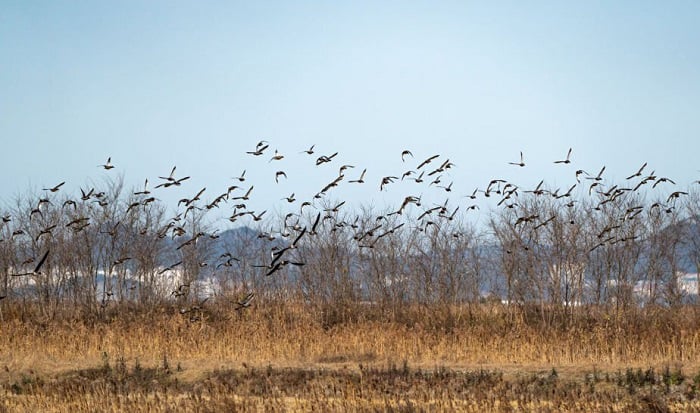Avians indeed hold one of the most bizarre behaviors among the Kingdom Animalia. With their unique characteristics, some birds can sing, some can dance, and some swim. But why do birds fly south for the winter?
The ultimate answer to that is food. Once the winter wind blows, their food resources begin to decline, which creates a substantial impact on their survival. Keep reading as we will delve more into a deeper understanding of bird migration.
Table of Contents
Birds Migrate South in the Winter Due to Food Shortage
Plants, insects, and food drops are abundant throughout the summer season, offering birds a great deal of food to eat. In fact, birds settle in locations where they may find the finest food sources for both themselves and their young.
However, these food supplies tend to plummet as winter approaches, making it difficult for them to survive. To prevent starvation, birds migrate to warmer places.
Along with its freezing temperature, the snow and ice during winter also challenge the birds to secure safe nesting locations. Staying places their health at risk and makes them vulnerable to predation.
Thus, birds flying south for the winter don’t only help them find their food sources but also shelter them in a safer and more suitable ecosystem.
Birds Flying South for Winter Is a Matter of Life and Death
We have already tackled that the reason why birds fly in the winter is to survive starvation. But the truth is, various natural and man-made threats are also waiting for them before they even reach the south.
A wide range of natural hazards includes predators, exhaustion, disease, and disasters.
- Migratory birds are astounding for flying miles of distance. But when exhaustion strikes, they will be more prone to diseases, predators, and a higher chance to falter in flight.
- Additionally, flying in a flock makes it easier for collisions and disease outbreaks to spread. If this ever happens, a devastating number of birds would die during migration.
- On a more serious side, man-made threats pose extremely dangerous effects on bird migration. Loss of habitat due to civilization and pollution contributes to a significant negative impact on their ecosystem.
For instance, when migratory birds rest and start to starve along their route, the destructed habitats aggravated by pollution will make it harder for birds to find food sources and temporary shelters for them to migrate successfully.
- And when they reach the south, would that be the end of their perilous odyssey? Certainly not. Diminished shelters and food sources affect the survival of migratory birds during and after their flight.
Not All Birds Fly South for the Winter
While some birds are headed to warmer places during winter, some birds, such as Common Raven, Blue Jay, and Northern Mockingbird, stay around for the winter.
Experts found that birds can endure the toughest weather as long as there is an adequate food supply. And this is possible due to their none other than and very own insulator – feathers.
There Are Different Types of Migrating Birds
In the world of avians, bird migration is defined as a seasonal movement, flying over thousands of kilometers between breeding and wintering regions.
Surprisingly, nearly half of the world’s bird species are regular migrants! For the numbers, this is about 40% of the total bird population, and 4000 out of 10,000 known bird species.
These are some of the migratory birds you might have observed above the sky:
- Winter Visitors – They arrive at Britain’s shores during autumn when the weather is warmer, and food is more accessible. They will eventually go back to their breeding areas when spring approaches. Included here are the Sanderling, Barnacle goose, and Redwing.
- Summer Visitors – They arrive in spring coming from the south for breeding. Examples are Nightingale, Wood warbler, and Turtle dove.
- Altitudinal Migrants – Also called vertical migration. These birds move up and down, unlike other birds migrating between north and south, east and west. They include white-ruffed manakin and various species of hummingbird.
- Partial Migrants – Common across migratory species, where some members of a population migrate while others remain sedentary. It includes the goldfinches and chaffinch.
FAQs
Well, there’s no exact answer for that, but here’s what we know. Migratory reflexes and the ability to navigate could be genetically encoded.
Researchers also revealed the theory that birds have a magnetic mineral inside their brain which could enable them to detect Earth’s magnetic field. Another impressive study is that they use constellations to navigate during the night times.
2. Why do birds assemble in V formation during the flight?
You might notice most birds fly in a V formation as they migrate. Such a formation allows easier flying, saving them energy during the long journey. In fact, this same principle is applied to aircraft.
Also, birds follow their leaders to ensure protection and the right direction during migration.
3. Why do migratory birds fly south for the winter?
Because it is too far to walk. Just kidding! That one is for the winter joke entry and geometry worksheet answers. On a serious note, birds fly in the winter because of reduced food supplies necessary for their survival.
Conclusion
The avian species has evolved into spectacular and brilliant creatures. Their adaptation skills allowed them to experience the world above seas and mountains, unlike any other life form.
The public and well-studied researchers have appreciated these extraordinary behaviors of migratory birds by researchers.
Now that you are illuminated on why do birds fly south for the winter, we hope that you enjoyed your quick yet informative, exhilarating journey reading this article. If there is more you want to expand, feel free to share the information with others.
Related articles about bird behaviors in winter:

George and I became friends after a birdwatching trip with our new group. And we have been enjoying every adventure together. When he told me the idea of establishing a site that shares our experiences and fun, I immediately agreed. After trials and errors, here we have Thayerbirding.

















